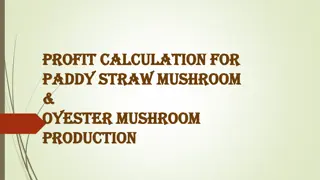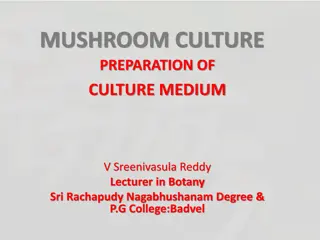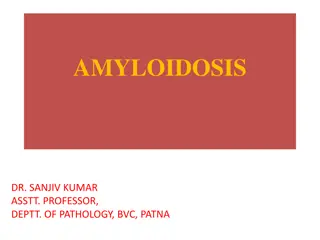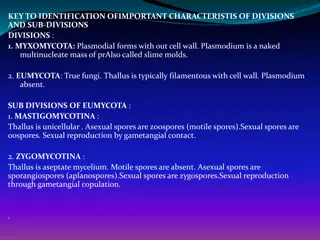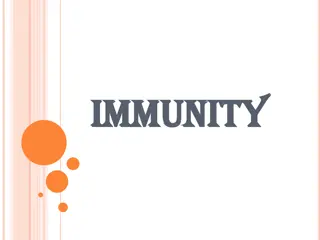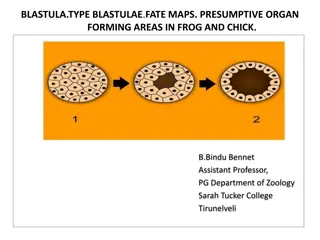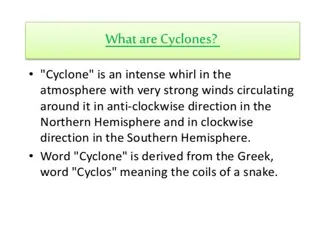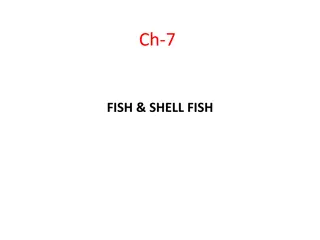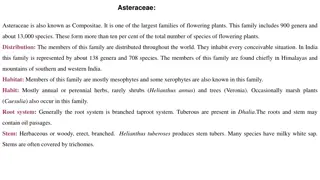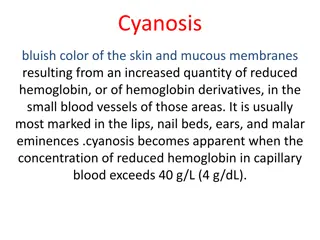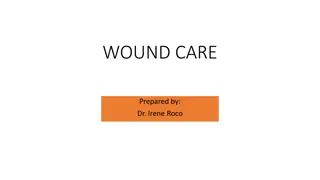Understanding Mushroom Types and Characteristics
Mushrooms, consumed as energy-rich food, come in various types like poisonous and common edible mushrooms. Poisonous mushrooms contain toxins that can be harmful, while edible mushrooms offer a variety of nutritious options. Learn about the features and symptoms associated with poisonous mushrooms and the families of common edible mushrooms available worldwide.
Uploaded on Jul 13, 2024 | 1 Views
Download Presentation

Please find below an Image/Link to download the presentation.
The content on the website is provided AS IS for your information and personal use only. It may not be sold, licensed, or shared on other websites without obtaining consent from the author. Download presentation by click this link. If you encounter any issues during the download, it is possible that the publisher has removed the file from their server.
E N D
Presentation Transcript
UNIT II MUSHROOM METHODOLOGY
HAJEE KARUTHA ROWTHER HOWDIA COLLEGE UTHAMAPALAYAM DEPARTMENT OF BIOCHEMISTRY NAME : S. MUTHUPRIYA STAFF CODE: TNMK021SFT127 COURSE NAME: FOOD BIOTECHNOLOGY COURSE CODE: 17UBCE62 TOPIC: TYPES OF MUSHROOM
They are consumed as energy rich food. These fungi live as saprophytes in dead organic matter in the form of mat of interwined hyphae. The hyphae produce white tiny balls of hyphae called buttons. The buttons consist of a short stalk and a cap called pileus. They open towards maturity and form mature fruit bodies.
Types of Mushroom There are two types 1. Poisonous mushroom 2. Common edible mushroom I. Poisonous Mushroom: Several mushroom contain toxins called mushroom toxins in their fruit bodies. Mushroom toxins are poisonous to man. The mushroom which are not accepted by human body, are known as poisonous mushroom or toad stool. Mushroom toxins cause many disorders in man and even death may result.
Features of poisonous mushroom: Poisonous Mushroom look like edible mushroom in their morphology and life cycle. 1. Brightly coloured fruit body 2. Greenish tingle on gills and yellow green spores. 3. Pink coloured spores in gills. 4. Presence of vulva and annulus on the stalk. 5. Unpleasant odour.
Symptoms of Poisonous Mushroom: The symptoms of mushroom poisoning appears only after 8- 24 hours of ingesting poisonous Mushroom. Mushroom poisonoing shows the following symptoms: 1. Nervous disorder 2. Gastric disorder 3. Haemolysis 4. Muscular disorder 5. Damage in liver cells
II. Common Edible Mushroom: There are about 100 species of edible mushroom all over the world. There are three families of common edible mushroom 1. Agaricus bisporus 2. Volvariella volvacea 3. Pleurotus sajor-caju
1. Agaricus bisporus: Agaricus bisporus is commonly known as white button mushroom or temperate field mushroom. The young fruit body of this fungus looks like a large white button with a short stalk. It consists of a weft of hyphae. The button stage mushroom are used for human consumption. Mature Basidiocarp consists of a fleshy stalk called stipe and a large circular, umbrella like expansion called cap or pileus.
Before maturity, the edge of the cap remains attached with the stipe by a membrane called veilum or partial veil. The veilum gets ruptured during expansion of the cap. It leaves a rugged fringe of tissue called annulus at the top of the stipe. The cap is 8-10 cm in diameter. Its colour may vary from white to brown.
The upper surface of the cap is slightly convex. From the lower surface of the cap many vertical plates of fertile tissue arise and run in radiating rows. Such vertical plates are called gills or lamellae. The gills bear many haploid reproductive spores called Basidiospores. The base of stalk is slightly hard and brown in colour.
2. Volvariella volvacea It is popularly known as Chinese mushroom or paddy straw mushroom or tropical mushroom. It is common in tropical and sub tropical zones. It should be eaten fresh. The young fruit body called sporophore is egg shaped and dark grey in colour. It is covered by a coat called universal veil. The nature sporophore consists of a fleshy stipe and a grey colored gap.
The stipe is 3-8 cm height and has a conspicuous cup like structure called valve at the base. It has no annulus. The cap or pileus is 6-12 cm in diameter. The upper surface is slightly convex and the lower surface is slightly concave. Many radiating rows of gills occur on the lower surface of the cap. The gills are brownish pink in colour and they bear numerous pink coloured basidiospores.
3. Pleurotus sajor-caju: It is known as Indian oyster mushroom It grows well in most cellulosic wastes rich in lignin. The young sporophore is small, white and button like structure. The gills are of three types, 1. Long gills 2. Medium gills 3. Short gills
They are arranged alternatively. Each of the gills numerous haploid basidiospores. The stipe is short, lateral and grey or white in colour.
REFERENCE: Food Technology: An introduction book by Anita Tull. Food Processing Technology- Text book by P. Fellows


